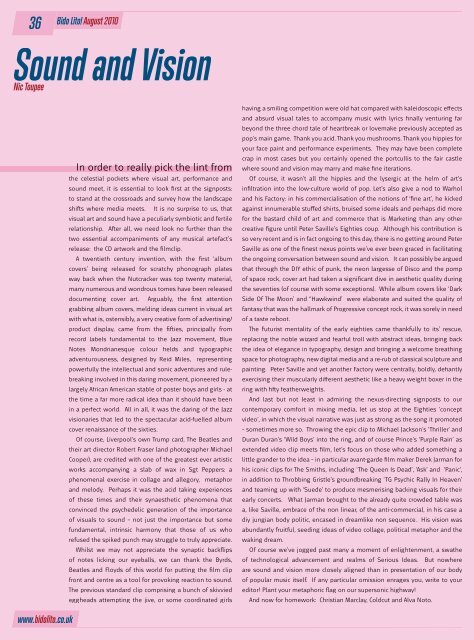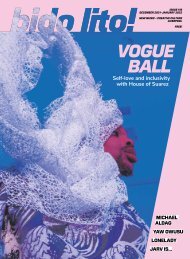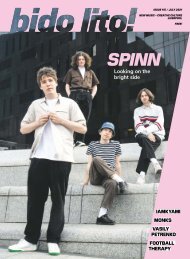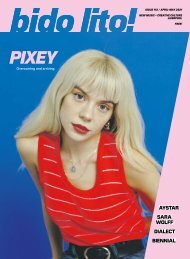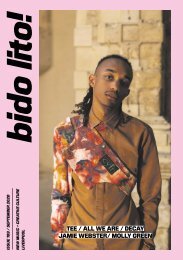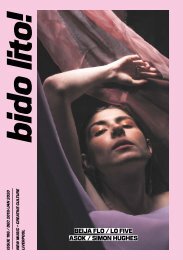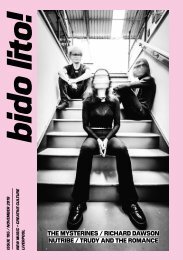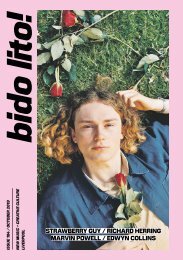Issue 3 / August 2010
In Issue 3, August 2010 of Bido Lito! With cover artists THE CORAL, and features on SHELLSUIT, HOT CLUB DE PARIS, NEVILLE SKELLY, SOUND OF GUNS, SEAN FRANCIS BUTLER, CAPAC and much more.
In Issue 3, August 2010 of Bido Lito! With cover artists THE CORAL, and features on SHELLSUIT, HOT CLUB DE PARIS, NEVILLE SKELLY, SOUND OF GUNS, SEAN FRANCIS BUTLER, CAPAC and much more.
Create successful ePaper yourself
Turn your PDF publications into a flip-book with our unique Google optimized e-Paper software.
36<br />
Bido Lito! <strong>August</strong> <strong>2010</strong><br />
Sound and Vision<br />
Nic Toupee<br />
Nic Toupee<br />
In order to really pick the lint from<br />
the celestial pockets where visual art, performance and<br />
sound meet, it is essential to look first at the signposts:<br />
to stand at the crossroads and survey how the landscape<br />
shifts where media meets.<br />
It is no surprise to us, that<br />
visual art and sound have a peculiarly symbiotic and fertile<br />
relationship. After all, we need look no further than the<br />
two essential accompaniments of any musical artefact’s<br />
release: the CD artwork and the filmclip.<br />
A twentieth century invention, with the first ‘album<br />
covers’ being released for scratchy phonograph plates<br />
way back when the Nutcracker was top twenty material,<br />
many numerous and wondrous tomes have been released<br />
documenting cover art.<br />
Arguably, the first attention<br />
grabbing album covers, melding ideas current in visual art<br />
with what is, ostensibly, a very creative form of advertising/<br />
product display, came from the fifties, principally from<br />
record labels fundamental to the Jazz movement, Blue<br />
Notes Mondrianesque colour fields and typographic<br />
adventurousness, designed by Reid Miles, representing<br />
powerfully the intellectual and sonic adventures and rulebreaking<br />
involved in this daring movement, pioneered by a<br />
largely African American stable of poster boys and girls - at<br />
the time a far more radical idea than it should have been<br />
in a perfect world. All in all, it was the daring of the Jazz<br />
visionaries that led to the spectacular acid-fuelled album<br />
cover renaissance of the sixties.<br />
Of course, Liverpool’s own Trump card, The Beatles and<br />
their art director Robert Fraser (and photographer Michael<br />
Cooper), are credited with one of the greatest ever artistic<br />
works accompanying a slab of wax in Sgt Peppers: a<br />
phenomenal exercise in collage and allegory, metaphor<br />
and melody. Perhaps it was the acid taking experiences<br />
of these times and their synaesthetic phenomena that<br />
convinced the psychedelic generation of the importance<br />
of visuals to sound – not just the importance but some<br />
fundamental, intrinsic harmony that those of us who<br />
refused the spiked punch may struggle to truly appreciate.<br />
Whilst we may not appreciate the synaptic backflips<br />
of notes licking our eyeballs, we can thank the Byrds,<br />
Beatles and Floyds of this world for putting the film clip<br />
front and centre as a tool for provoking reaction to sound.<br />
The previous standard clip comprising a bunch of skivvied<br />
eggheads attempting the jive, or some coordinated girls<br />
having a smiling competition were old hat compared with kaleidoscopic effects<br />
and absurd visual tales to accompany music with lyrics finally venturing far<br />
beyond the three chord tale of heartbreak or lovemake previously accepted as<br />
pop’s main game. Thank you acid. Thank you mushrooms. Thank you hippies for<br />
your face paint and performance experiments. They may have been complete<br />
crap in most cases but you certainly opened the portcullis to the fair castle<br />
where sound and vision may marry and make fine iterations.<br />
Of course, it wasn’t all the hippies and the lysergic at the helm of art’s<br />
infiltration into the low-culture world of pop. Let’s also give a nod to Warhol<br />
and his Factory: in his commercialisation of the notions of ‘fine art’, he kicked<br />
against innumerable stuffed shirts, bruised some ideals and perhaps did more<br />
for the bastard child of art and commerce that is Marketing than any other<br />
creative figure until Peter Saville’s Eighties coup. Although his contribution is<br />
so very recent and is in fact ongoing to this day, there is no getting around Peter<br />
Saville as one of the finest nexus points we’ve ever been graced in facilitating<br />
the ongoing conversation between sound and vision. It can possibly be argued<br />
that through the DIY ethic of punk, the neon largesse of Disco and the pomp<br />
of space rock, cover art had taken a significant dive in aesthetic quality during<br />
the seventies (of course with some exceptions). While album covers like ‘Dark<br />
Side Of The Moon’ and “Hawkwind’ were elaborate and suited the quality of<br />
fantasy that was the hallmark of Progressive concept rock, it was sorely in need<br />
of a taste reboot.<br />
The Futurist mentality of the early eighties came thankfully to its’ rescue,<br />
replacing the noble wizard and fearful troll with abstract ideas, bringing back<br />
the idea of elegance in typography, design and bringing a welcome breathing<br />
space for photography, new digital media and a re-rub of classical sculpture and<br />
painting. Peter Saville and yet another Factory were centrally, boldly, defiantly<br />
exercising their muscularly different aesthetic like a heavy weight boxer in the<br />
ring with fifty featherweights.<br />
And last but not least in admiring the nexus-directing signposts to our<br />
contemporary comfort in mixing media, let us stop at the Eighties ‘concept<br />
video’, in which the visual narrative was just as strong as the song it promoted<br />
– sometimes more so. Throwing the epic clip to Michael Jackson’s ‘Thriller’ and<br />
Duran Duran’s ‘Wild Boys’ into the ring, and of course Prince’s ‘Purple Rain’ as<br />
extended video clip meets film, let’s focus on those who added something a<br />
little grander to the idea – in particular avant-garde film maker Derek Jarman for<br />
his iconic clips for The Smiths, including ‘The Queen Is Dead’, ‘Ask’ and ‘Panic’,<br />
in addition to Throbbing Gristle’s groundbreaking ‘TG Psychic Rally In Heaven’<br />
and teaming up with ‘Suede’ to produce mesmerising backing visuals for their<br />
early concerts. What Jarman brought to the already quite crowded table was<br />
a, like Saville, embrace of the non linear, of the anti-commercial, in his case a<br />
diy jungian body politic, encased in dreamlike non sequence. His vision was<br />
abundantly fruitful, seeding ideas of video collage, political metaphor and the<br />
waking dream.<br />
Of course we’ve jogged past many a moment of enlightenment, a swathe<br />
of technological advancement and realms of Serious Ideas. But nowhere<br />
are sound and vision more closely aligned than in presentation of our body<br />
of popular music itself. If any particular omission enrages you, write to your<br />
editor! Plant your metaphoric flag on our supersonic highway!<br />
And now for homework: Christian Marclay, Coldcut and Alva Noto.<br />
www.bidolito.co.uk


